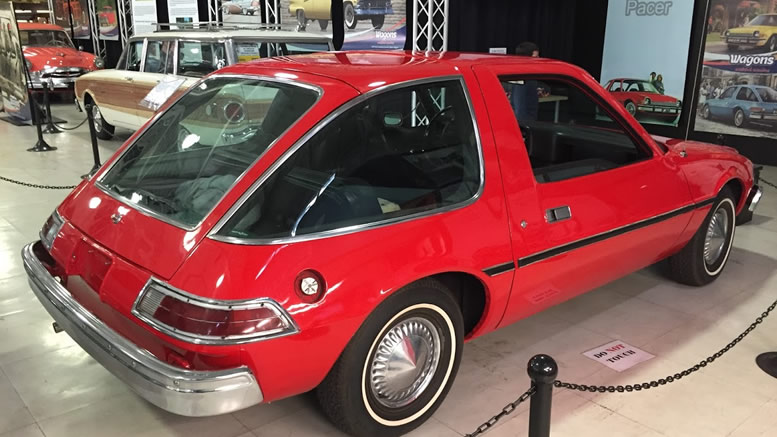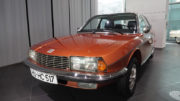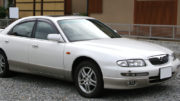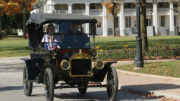
The AMC Pacer was a two-door, compact car produced in the USA by American Motors Corporation between 1975 and 1980, although design started in 1971. Its unusual, bulbous look and differently-sized doors still make it an easily recognized icon of the 1970s.
The shape is highly rounded, even bulging from some aspects, with a huge glass area huge, especially for the time. It was very wide for a small car, almost as wide as an American full-size car.
One unusual feature is that the passenger-side door is four inches longer than the driver’s side, the rationale being to encourage rear-seat passengers to enter the car from the safer side.
AMC’s chief stylist Richard Teague began work on the car as early as 1971, anticipating an increased demand for smaller vehicles in the 1970s. This was before the fuel crisis or the flood of small foreign imports into the US market, so development was rather forward-thinking for the time. Teague’s original design featured front wheel drive and the use of a Wankel rotary engine from General Motors, who were at the time seriously intending wide-scale use of rotaries in production cars.
The fuel crisis killed off the Wankel rotary; GM cancelled development in 1974, unable to make an fuel-efficient powerplant with the technology available at the time. This left the Pacer without an engine, and while a replacement was quickly found, this was in the form of AMC’s existing straight-6 engine and transmission, necessitating rear wheel drive. The Pacer design didn’t have room for the transmission tunnel required, but AMC couldn’t afford the time or money to completely redesign. Instead, the space was created by the simple expedient of widening the Pacer six inches to give room for the driveshaft. This left the Pacer unusually wide for a compact car, but gave it a very good ride and plenty of interior space.
In its first year of production, the Pacer sold well, with 145,528 units. It was an American designed and built compact car, and that was enough. Competition was not too stiff from American makes, most of whom had been blindsided by the oil crisis and the sudden demand for compact, economy vehicles (some to the extent that they had to import cars from their European subsidiaries or affiliates), while many buyers did not desire a foreign-built vehicle (they were also quite expensive). Sales fell rapidly from there, however, and production ceased in 1980 with only 280,000 cars built. Improved competition and resistance to the Pacer’s unusual styling are often cited as the reasons.
The Pacer’s drawbacks, aside from unusual looks, included a lack of cargo space (thanks to the fuel tank being relocated to the trunk) and a lack of power; the Pacer was quite heavy and the AMC straight six quite old and under powered. In 1976, a 4.2 litre High Output engine was offered, which helped the performance at the then-unacceptable cost of much higher fuel consumption. A 5.0 litre V8 was offered from 1978, but by then the Pacer was old and outmoded, and it did little for sales.
A station wagon body style was offered from 1977, and was rare. It featured simulated wood-grain paneling on the lower bodysides and the rear door.
Pacers made a number of movie appearances, largely out of being a 1970s icon and being commonly considered an ugly or weird-looking car. The best known was in the popular 1992 comedy Wayne’s World and its sequel, featuring a number of Pacers including a convertible and a stretch Pacer limousine.
A number of TV shows and commercials have used Pacers when they wanted a 1970s feel.
As of 2003 a Pacer is not a highly valuable car, though many now have ‘classic’ status at 25 years old or more. The maximum value listed for any Pacer in the N.A.D.A. appraisal guide is almost $7,000 US for a 1977 Pacer station wagon in perfect condition. The cars do have a cult following, especially among fans of the 1970s look.




